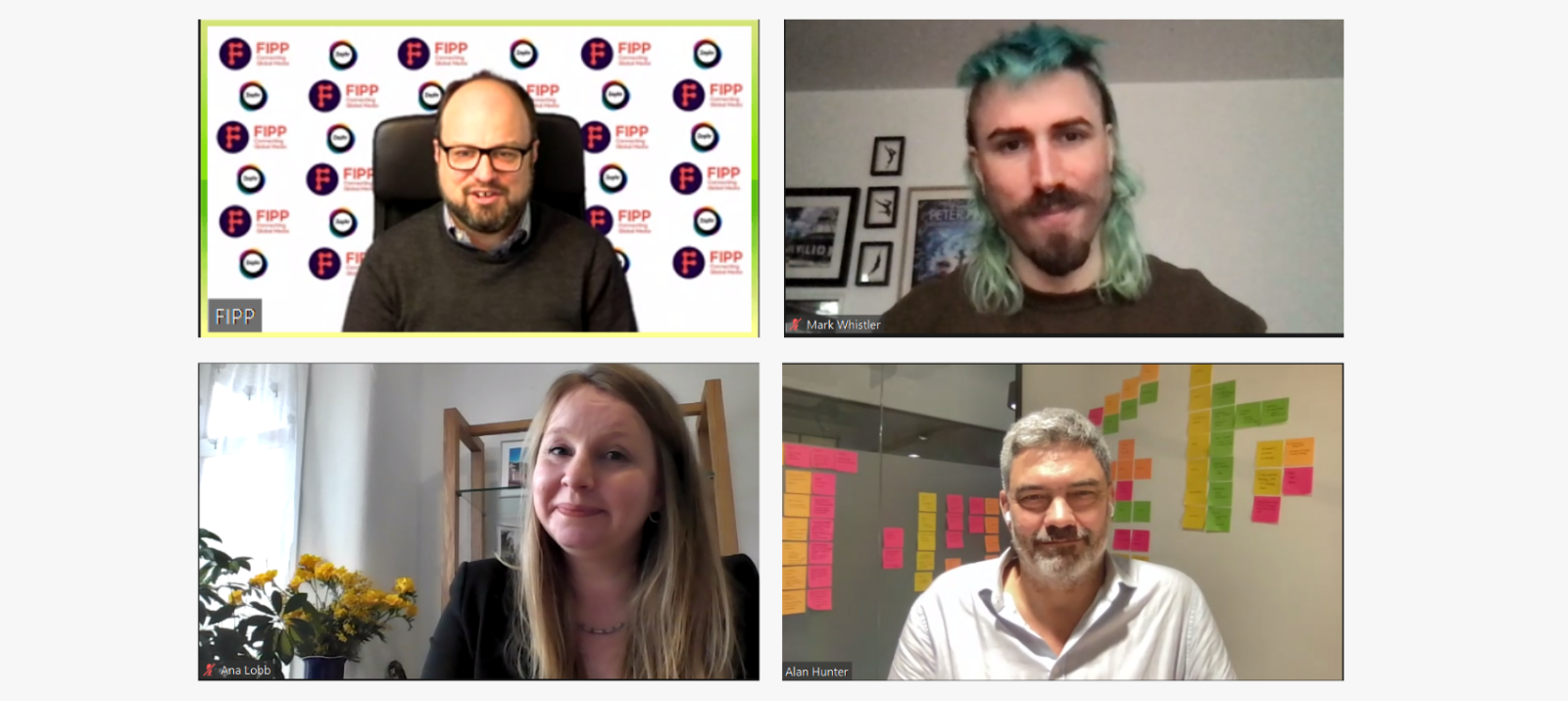Preparing for the post-cookie world using paywalls, subs and first-party data: FIPP panel discussion
Publishers can feel optimistic about all the different ways they can harness subscriptions and first-party data, even as the coming demise of third-party cookies puts pressure on existing business models, according to our panel of experts at the latest FIPP Insider webinar yesterday.
FIPP President and CEO James Hewes was joined by Alan Hunter from HBM Advisory, Ana Lobb from MPP Global, and Mark Whistler from Zephr. They discussed the structural reasons for many publishers’ reliance on data, which d2c strategies work best and why, common hitches and how to overcome them, and much more.

Context: the game has changed
As most people working in media know by now, the impending phaseout by Google of third-party cookies on its Chrome browser – the world’s most popular – will have enormous implications for media brands and advertisers. What’s more, social media has completely altered the advertising rulebook.
Alan Hunter, who has worked with The Times, began by explaining why a paid content model is so appealing in this context. “Advertisers used to pay us in the past because of our access to our audiences,” he said. “But now Facebook and those like them can provide that audience too. The ad business is a very difficult space for publishers to be in, so the reader revenue model looks a lot more attractive.”
That’s because you own the relationship: you have direct access, you can add subscribers, and you have returning customers in the form of those subscribers, he said. “Subscribers not pure profit but they’re not far off. It also helps bring you closer to your customers, because you’re responding directly to what they want,” he added.
All this is occurring in the context of much greater user awareness about data privacy. “There’s a push for more regulation around how anonymous data is used,” said Ana Lobb. “The main way that third-party cookies will change us is that we won’t be able to track users from third-party websites any more. People will be more treated as individuals, rather than as more crude categories.”
What’s interesting to her about paywalls is that because of the changes with cookies, first-party data is getting more limelight again. “We all ask people to share their data – collecting first-party data like this is one of the most important steps, and quite often it’s the paywall that does that.”
While the aim with subscriptions is, of course, to “backfill pots of revenue”, Lobb emphasised that data has another purpose: “as publishers we first need to really understand our customers and understand what our value proposition. And that’s all underpinned by data.”
From his experience at Zephr, Mark Whistler has noticed very positive reactions to paywalls and subscription strategies that they develop together. “Clients tell us that it helps shift power back into journalists’ and editors’ hands, because they’re not hamstrung by having to create content that creates value for advertisers. Ultimately, this is helping publishers to create better value for their clients.”
All this is occurring in the context of much greater user awareness about data privacy. “There’s a push for more regulation around how anonymous data is used,” said Lobb. “The main way that third-party cookies will change us is that we won’t be able to track users from third-party websites any more. People will be more treated as individuals, rather than as more crude categories.”

The opportunity for magazine media
FIPP’s James Hewes made the point that newspapers have been good at diversifying their revenue streams, magazines less so. What, then, is the opportunity for magazine publishers in getting a good mix?
Lobb agreed that all publishers need a mix of revenue streams. “The paywall isn’t going to save us all,” she noted. “One reason it’s harder for magazines is because traditionally, they have outsourced customer management so it’s much harder for them to understand the full customer journey. It’s very much been advertorial content in magazines, and it’s difficult to put a paywall on that kind of content.”
Nonetheless, she said, video, audio and interactive products are the kind of products that a paywall can absolutely be applied to, and that magazine media can create well.
Hunter added that there are sometimes tech limitations, but that niche magazines in particular provide something that people want to pay for: “The case for investing in the technology has been there for a while. I think that magazines especially have a huge opportunity to do paid content, particularly if they’re a specialist magazine. People pay for things online that they can’t get anywhere else. Generalist newspapers are less able to provide that; some will thrive, but there’s a bigger growth opportunity in the specialist sector, because you’re feeding people’s passions, providing something they can’t get elsewhere. ‘Mile deep, inch wide’ not ‘inch deep, mile wide’, so to speak.”
I see data as a gift that a subs team could give to an ads team that could unite their aims.
Ana Lobb
Whistler added: “One of the things we think about is where the power lies, and how data flows. Magazine media can own the distribution through digital and through apps; we encourage them not to be hamstrung by classic legacy print methodologies.
“From a technology perspective, some of these fulfilment houses are trying to build systems themselves, and as more magazine media come on board, we’re getting increased requests to help in dealing with this step towards being a diverse provider of these services.”
Diverse revenue approach is key
Nonetheless, better tech must not come at the expense of print, warned Lobb. “We must remember that across Europe, 80 per cent of subscription revenue still comes from print,” she said. “You need a combined strategy really: you’re either using a print legacy system or a digital revenue system, or a combination of the two. Things like apps, or subscription boxes, can complement print magazines well. There should always be a mix, and all publishers should think about how to get the mix right.”
Hunter added: “The thing to remember is that 95 per cent of your audience will never become paying subscribers. That sounds a bit depressing, but it’ll be more than made up for by the revenue you get from your ‘superfans’ that are in the 5 per cent,” he explained.
“This means that you can run an advertising business and a subscription business at the same time – despite having a paywall for a decade, the NYT just moved into being a majority digital revenue publisher. In spite of their impressive subscriber numbers, they’re also one of the world’s biggest advertising businesses. One doesn’t have to mean negating the other.”
Lobb commented that the NYT is especially good at diversifying: “A new kids’ magazine on Saturdays; buying Wordle – all because they knew their audience well and recognised that they love puzzles.
For Lobb, “I see data as a gift that a subs team could give to an ads team that could unite their aims – first party data is more accurate than anything we can model, and it can then feed the advertising side of the business.”
I would say that your data is your readers.
Alan Hunter
Understanding what makes a good revenue mix begins with mapping past and future approaches. “The first thing to do is to understand your revenue mix today, and look at how it was in the past,” said Whistler.
“If your users have no concept of even a registration on your site, it might be risky to throw up even a metred, let alone a hard paywall. So it’s important to understand your audience, see what content your audience comes to the site for. Asking for a paid exchange can come later, once you have primed your audience for potentially paying for content, and gathered some data via registrations which you can use for personalisation.
“In this world, data is king (especially with the death of third-party cookies) – but how you build your strategy piece by piece, over time, is what will separate those publishers from those who want a quick win or speedy victory.”
Letting the data guide your strategy (but not dictate it)
All the panellists undoubtedly agreed that data is incredibly important. “I would say that your data is your readers. You have to be prepared that the answer might not be what you think – at The Times, we discovered that people only read one or two stories rather than five or six on a particular big story, so we narrowed the focus down to just a few good quality articles on a given issue.
“Being informed by the data is very important. It’s about knowing what your audience finds valuable in what you do – and data lets you do that in real time.”
Knowing your audience, valuing what you offer them
Whistler highlighted that any kind of paywall – whether intelligent, soft, or metred – can be really helpful in establishing facts about a relatively unknown audience. “What are people consuming, and how likely are they to pay for that content? For instance, someone that comes to your site specifically for your sports content is much more likely to convert than a more general user.”
One of the biggest mistakes is assuming that the subs journey ends when someone clicks subscribe.
Mark Whistler
Lobb added: “As with any product, a subscription needs to be marketed – delivering real-time messages that offer personalisation and value.” Publishers can consider creating voucher codes, offers – because “subscriber acquisition peaks when we experiment with tools like this. Free trials with rolling payment obviously convert more and have good retention rates.”
Across Europe, we see some newspaper publishers opting for a two- or three-year subscription upfront, because they know that the retention rate is much higher. “The crux is continual experimentation. It’s a marathon not a sprint.”
Hunter advised some caution on giving too much away, though. “There was a time when publishers thought freebies and giveaways would make people subscribe. You should always lead with the content and be wary of discounting – discount with care! It can encourage people to step over the line, but don’t get them locked into an eternal discounted mindset. If you suddenly jack up the price after a month’s free trial, there’s a risk that people will be affronted.”
Whistler pointed out a common blind spot in the mindsets of people that he works with at Zephr. “It’s called a recurring revenue model for a reason – one of the biggest mistakes is assuming that the subs journey ends when someone clicks subscribe,” he said. “We need to look at the relationship beyond the first contact.”
Making things easy for the user – micropayments and smooth customer service
As the end of the session neared, Whistler pointed out that one of the core tenets of the day’s session had been revenue diversity. “And not only recurring subscriptions, but one-off payments or transactions have to be something publishers consider in their arsenal,” he urged. “There are times when I’d subscribe to NYT during particular moments of the American political cycle, for example, but I don’t want to be a subscriber all the time.
“We have a world where everything is packaged, with optional add-ons – so if you’re providing specific, unique value and the customer is willing to pay for it, that should be something you embrace as a revenue stream.”
Lobb pointed beyond publishing: “Particularly throughout the pandemic, OTT (over-the-top) and on-demand models have grown, but we’ve also seen on-demand events with our customers like Live Now – hosting concerts with Dua Lipa, Gorillaz etc. which are ticketed events.”
High quality customer experience is now demanded by users, too, said Hunter. “Automated customer service is available and is worth looking into. Something that’s high on the list of priorities – as in, it’s at the top of users’ minds – is this, because they’re used to getting what they see as exceptional customer service according to what’s convenient for them (the Netflix model) where you can continually subscribe and unsubscribe, at will. This is something that publishers can try to do too, to make the journey as frictionless as possible.
“Churn is your enemy if you’re a more mature subscription business. Obsessing over reducing churn is what’ll keep you going in the long term. But before that point, it’s all about acquisition; getting people in.”
Lobb agreed: “We need to become more customer-centric. Literally putting ourselves in their shoes – there are still sometimes too many ads, too many popups. We must understand our value proposition and use engagement metrics to encourage people to come back.”










